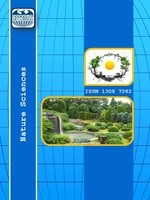GEOLOGICAL CHARACTERISTICS OF THE REGION GEREDE (BOLU)
The study area covers an area of approximately 600km2 in the Gerede district of the Province of Bolu, which is located in 1/25.000 scale G28 a1 a2 a3 a4 topographical sheets showing north-west of Turkey. This study tried to reveal the general geology of the study region, which is bound by the Mengen district on the north and Gerede district on the southeast. The study area includes various rocks with similar lithology and stratigraphic sequence with ages ranging from the Paleozoic to Quaternary period. Although the base complex, which constitutes the oldest, rocks of the region, cannot be observed in the mapped geographical area in Gerede, though it's known to exist at the base. The limestones developed on the tithonic facies of Late Jurassic-Early Cretaceous age on the base complex of Permo-Triassic period are incompatible. It is determined that the Upper Jurassic-Lower Cretaceous aged limestones are rich in titonic facies and rich in calpionel contents. As a result of detailed paleontological and biostratigraphic studies on the samples; 3 calpionel species and 7 species of these species, including Tintinnopsella carpathica (Murgeanui & Filipescu), Crassicollaria brevis Remane, Crassicollaria intermedia (Durand Delga), Crassicollaria parvula Remane, Crassicollaria massutiniana (Colom), Calpionella alpina Lorenz, Calpionella elliptica Cadisch. It was determined in the study area, the lower levels of Upper Cretaceous are composed of sandstone-shale-marl intercalated flysch and clayey limestones containing agglomerate intercalations and the Maastrichtian level are composed of rocks and felsic intrusive rocks in the volcano-flysch facies. Among Maestrichtian age-giving units; Globotruncana arca Cushman, Globotruncanita conica White, Rosita contusa (Cushman) and Globotruncana sp. planktonic foraminifera were detected. Considering the relationship between the rocks in the region, the presence of a gradual transgression along the Mesozoic is noteworthy. It is composed of Tertiary, Paleocene aged sandstone shales, agglomerate, Lutetian, Miocene and Neogene aged terrestrial formations with volcanic activities, occurred in a marine environment and particularly observed in the western part.
Anahtar Kelimeler:
Gerede, General Geology, Stratigraphy, Paleozoyik, Bolu
GEOLOGICAL CHARACTERISTICS OF THE REGION GEREDE (BOLU)
___
- [1] Ajdukiewicz, Z., Mankiewicz, M. ve Pieniazek, J., (1946). Bolu Bitümlü Şistleri Hakkında Nihai Rapor. MTA Rapor No:1668.
- [2] Baykal, F., (1954). Ulus-Eflani Arasındaki Mıntıka Hakkında Jeolojik Rapor: Maden Tetkik ve Arama Enstitüsü, Rapor, No:2125 (Yayımlanmamış).
- [3] Blumenthal, M., (1937). Bolu Vilayeti Dahilindeki Gökdağ Mıntıkası Bitümlü Şist Sahasının Jeolojisi Hakkında Rapor. MTA No:269.
- [4] Cerit, O., (1983). Mengen (Bolu) Yöresinin Jeolojik Incelemesi. Hacettepe üniversitesi Fen Bil. Ens. Yüksek Lisans Tezi (Yayınlanmamış), Ankara, 160s.
- [5] Erdem, İ. ve Akalın, L., (1983). Mengen-Salıpazarı-Merkeşler Kömür Sahası Hakkında Rapor. MTA Rapor No:7421.
- [6] Kaya, O., (1982). Ereğli, Yığılca, Bolu Kuzey, Mengen Alanlarının Stratigrafi ve Yapı Özellikleri: Türkiye Petrolleri A.O., Arama Grubu, Rapor No:1639 (Yayımlanmamış).
- [7] Ketin, İ., (1967). Bolu, Gerede, Mengen ve Yığılca bölgesindeki Paleozoyik Teşekkülere Ait Jeolojik Rapor: Türkiye Petrolleri A. O., Arama Grubu, Rapor No:379 (Yayımlanmamış).
- [8] Kipman, E., (1974). Sakarya, Çamdağ Alanının Jeolojisi: İstanbul Üniversitesi, Fen Fakültesi Doktora Tezi (yayımlanmamış).
- [9] Lokman, K., (1939). Bolu (Mengen) Bitümlü Şistleri. MTA Rapor No:268.
- [10] Saner, S., (1980). Mudurnu-Göynük Havzasının Jura ve Sonrası Çökelim Nitelikleriyle Paleocoğrafya Yorumlaması. TJK Bülteni, c.23, n.1 s:39-52.
- [11] Sarı, A., (1999a). Source Rock Evaluation of Kabalar Formation in the Göynük Basin, Bolu, Turkey. 19th International Meeting on Organic Geochemistry. 6-10 September, İstanbul, Turkey. P:231-232.
- [12] Sarı, A. ve Sonel, N., (1995). Kayabaşı (Göynük-Bolu) Yöresinin Bitümlü Şeyl İncelemeleri. Türkiye Jeoloji Büllteni. C:2, n:2, s:39-49.
- [13] Sarı, A., (1999). Himmetoğlu Formasyonu (Göynük-Bolu) Bitümlü Şeyllerinin Organik Jeokimyasal İncelemesi. 1. Batı Anadolu Enerji Sempozyumu, 8-14 Mart, İzmir.
- [14] Sarı, A., Üzmez, B. ve Aliyev, S.A., (2004). Mengen (Bolu) Civarı Bitümlü, Şeyllerinin Hidrokarbon Potansiyeli. İstanbul Üniv. Müh. Fak. Yerbilimleri Dergisi, c:17, n:3.
- [15] Sonel, N., Sarı, A. ve Tozlu, E., (1987). Himmetoğlu (Göynük-Bolu)) Yöresinin Jeolojisi ve Linyit Oluşukları. Sakarya Üniversitesi, Müh. Mim. Fak. Dergisi, c:2, s:51-67.
- [16] Sonel, N., Kayabalı, K., Sarı, A. ve Tozlu, E., (1987). Ahmetbeyler (Göynük-Bolu)) Yöresinin Jeolojisi ve Yapısal özellikleri. S.Ü. Müh. Mim. Fak. Dergisi. C:2, s:37-50.
- [17] Uysalı, H., (1962). Kayaaltı-Salıpazarı-Mengen Bölgesi (Bolu) Kömür Sahasının Jeolojik Etüdü Hakkında Rapor. MTA rap.no:2931.
- [18] Tekin, E., ve Sarı, A., (2000). Kabalar Formasyonu (Göynük-Bolu) Bitümlü Şeylerinde Ki Hidrokarbon Damlalarının Morfolojileri. Yerbilimleri/Geosound Dergisi, n:36, s:107-121.
- [19] Tokay, M., (1952). Karadeniz Ereğlisi, Alaph, Kızıltepe, Alacaağzı Bölgesi Jeolojisi: Maden Tetkik ve Arama Enstitüsü Dergisi, sa., 4243, s:1-35.
- Başlangıç: 2009
- Yayıncı: E-Journal of New World Sciences Academy
